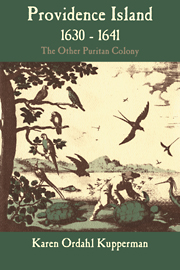Book contents
- Frontmatter
- Contents
- List of Maps
- Preface
- Author's Note
- 1 The Providence Island Company and Its Colony: The Program
- 2 Founding a Colony on Providence Island
- 3 Contested Authority: The Governorship of Captain Philip Bell
- 4 Frustrated Hopes for Economic Development
- 5 Land and Society: The Middling Planters
- 6 Servants into Slaves
- 7 Military Requirements and the People's Response
- 8 The Turbulent Religious Life of Providence Island
- 9 Governing Puritan Privateers: The Governorships of Robert Hunt and Nathaniel Butler
- 10 The Business History of the Providence Island Company
- 11 The End and Persistence of Providence Island
- Appendixes
- Bibliographical Essay
- Index
10 - The Business History of the Providence Island Company
Published online by Cambridge University Press: 24 November 2009
- Frontmatter
- Contents
- List of Maps
- Preface
- Author's Note
- 1 The Providence Island Company and Its Colony: The Program
- 2 Founding a Colony on Providence Island
- 3 Contested Authority: The Governorship of Captain Philip Bell
- 4 Frustrated Hopes for Economic Development
- 5 Land and Society: The Middling Planters
- 6 Servants into Slaves
- 7 Military Requirements and the People's Response
- 8 The Turbulent Religious Life of Providence Island
- 9 Governing Puritan Privateers: The Governorships of Robert Hunt and Nathaniel Butler
- 10 The Business History of the Providence Island Company
- 11 The End and Persistence of Providence Island
- Appendixes
- Bibliographical Essay
- Index
Summary
THE PROVIDENCE ISLAND COMPANY was organized in 1630 with a working capital of £3,800 promised from the twenty adventurers. (The Earl of Holland, perpetual company governor, was given a whole share without investing any money because the investors needed his court connections.) The size of each adventure, initially £200, was steadily increased as expenses mounted. By June 1632 it had reached £520, and by May 1633 it had reached the enormous sum of £1,025, at which the size of one whole adventure was frozen.
The investors were already involved in many ventures; they were seasoned veterans at organizing and running a colonial company. From the outset, they decided to conduct their affairs by the ballot box rather than by show of hands. The Virginia Company had turned to the ballot box when controversy threatened; it could also be useful as a way of allowing members to defy royal directives on election of specific officers. Elections of the key office of deputy governor (the effective head of the organization) were frequently contested in the Providence Island Company and were settled, without numbers being recorded, by ballot.
Providence Island Company organizers had worked together in many other colonial schemes; they had shown their willingness to invest both their energies and their money in projects to advance the interests of themselves and the nation. Many were members of the Virginia Company and its offshoot, the Somers Islands (Bermuda) Company. The Earl of Warwick and his kinsman, Sir Nathaniel Rich, led the Bermuda Company for decades; they held the balance of power in both companies as tensions developed between the merchants and gentleman-investors.
- Type
- Chapter
- Information
- Providence Island, 1630–1641The Other Puritan Colony, pp. 295 - 319Publisher: Cambridge University PressPrint publication year: 1993



